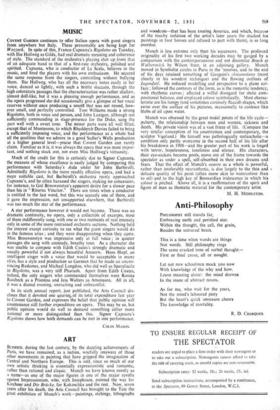ART
BLINDED, during the last.century, by the dazzling achievements of Paris, we have remained, as a nation, woefully unaware of those other movements in painting that have gripped: the imagination of Central and Northern Europe. This is odd, since so much of our own artistic thinking is essentially expressionistic and romantic, rather than rational and clafsic. Munch we have known mostly as a name—as one of the major figures in one of the major revolts against Impressionism, whit), wj.th Josephsson, pointed the way for Kirchner and Die Briicke, for Kokoschka and the rest. Now, seven years after his death, the Arts Council has brought to the Tate the great exhibition of Munch's work—paintings, etchings, lithographs
and woodcuts—that has been touring America, and which, because of the touchy isolation of the artist's later years (he stacked his paintings in four houses and refused to part with them), is so long overdue.
Munch is less extreme only than his successors. The profound originality of his first two working decades may be gauged by a comparison with the contemporaneous and not dissimilar Beach at Walberswick by Wilson Steer, in an adjoining gallery. Munch moved in Symbolist circles in Paris in the 'nineties, and to the end of his days retained something of Gauguin's cloisonnisme (most dearly in his woodcut technique) and the flowing outlines of Jugendstil. He reduced modelling and perspective to a plane sur- face ; followed the contours of the form, as is the romantic tendency, with rhythmic curves ; affected a wilful disregard for static com- positional balance, and employed colour symbolically. Most charac- teristic are his lumpy (and sometimes curiously flaccid) shapes, which swim over the surf-ace of his pictures, occasionally to coalesce like blobs of oil upon water.
Munch was obsessed by the great nodal points of the life cycle— puberty, the relationship between men and women, sickness and death. His private vision was of a vast frieze of life. (Compare the very similar conception of his countryman and contemporary, the sculptor Vigeland.) He himself was pathologically melancholic—a condition only partly overcome in the second half of his life after his breakdown in 1908—and the greater part of his work is tinged with terror, hopelessness, loneliness and silence. His characters, their eye-sockets become pools, move out of the frame towards the spectator as under a spell, self-absorbed in their own dreams and fears. That the effect of Munch's oeuvre as a whole is powerful, rather than intolerably neurasthenic, is due largely to the thin and • delicate quality of his paint (often more akin to watercolour than to oil) and to the high key of Bonnardian iridescence in which his colour is pitched. Above all, it is a reaffirmation of the spirit and figure of man as thematic material for the contemporary artist.
M. H. MIDDLETON.


































 Previous page
Previous page